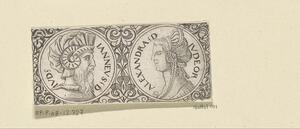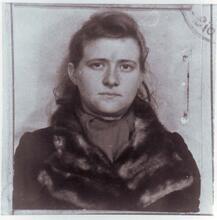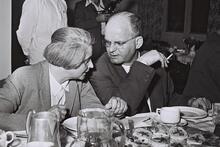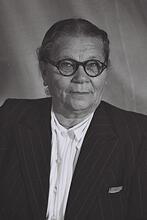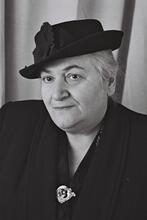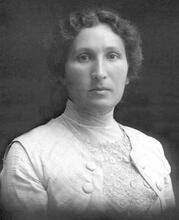Shelamziyyon Alexandra
Queen Shelamziyyon Alexandra ruled Judea in the 1st century BCE. During her reign, which was the only time a woman inherited the throne from her deceased spouse, she was most known for deposing the ruling party that had supported her husband. In the place of that party, she appointed the Pharisees, whose heirs portray her positively in the rabbinic literature they composed. She is also mentioned in a few other texts, such as the Dead Sea Scrolls.
Name and Lineage
Shelamziyyon Alexandra, Hasmonean Queen (76–67 BCE), was the wife and successor of King Alexander Yannai (Jannaeus) (c. 126–76 BCE). Our knowledge of her is principally derived from the writings of the Jewish historian Josephus, but she is also mentioned in rabbinic literature and in the Dead Sea scrolls. Her Hebrew name—Shelamziyyon—is a unique Second Temple invention, meaning peace of Zion, or wholeness of Zion. It is never recorded by Josephus, who only knows the queen by her Greek name—Alexandra—and it is usually preserved in odd ways in rabbinic literature (Shelamzi; Shelamzo; Shel Ziyyon). Only in the Dead Sea scrolls is the queen’s original Hebrew name preserved.
In the past it was assumed that Shelamziyyon Alexandra was also the widow of Alexander Yannai’s brother and predecessor King Judas Aristobulus I I (104–103 BCE), and that Alexander had taken her in Marriage between a widow whose husband died childless (the yevamah) and the brother of the deceased (the yavam or levir).levirate marriage after his brother, the king, had died childless. However, there is no ancient evidence for this assertion.
Reign
The queen’s most important and memorable internal political act was deposing the Sadducee ruling party, which had supported her husband, and appointing the Pharisees instead. Being a woman, and thus barred from officiating herself (as her predecessors had done), Shelamziyyon appointed her eldest son, Hyrcanus II (c. 103–30 BCE), high priest and successor, but this appointment was contested, even during her lifetime, by her other son, Aristobulus II (d. 49 BCE).
After her death civil rivalry broke out between the two, followed by the arrival of Roman rule in Palestine and the end of Jewish independence. The queen’s foreign policies were unimpressive; she supported a failed Jewish attempt to take Damascus, and corresponded with the Armenian king, Tigranes, when his armies approached the borders of her kingdom.
Shelamziyyon was the only Jewish queen to hold power during the Second Temple period. An earlier attempt, by her father-in-law, John Hyrcanus (reigned 135–104 BCE), to nominate his wife as his successor in a similar fashion, had failed, but his action may suggest that in the Hasmonean dynasty a wife succeeding her husband to the throne was the rule rather than the exception.
Twice Josephus relates the details of her rule. Once in his earlier version, in The Jewish War, he describes her positively: “Alexander bequeathed the kingdom to his wife Alexandra, being convinced that the Jews would bow to her authority as they would to no other, because by her utter lack of his brutality and by her opposition to his crimes she had won the affections of the populace.” However, in his later Jewish Antiquities he describes her negatively: “She was a woman who showed none of the weakness of her sex … being one of those inordinately desirous of power to rule. … For she valued the present more than the future, and … she had … no consideration for either decency or justice. … Matters turned out so unfortunately for her house that the sovereign power was not long afterward taken from it because of her desire of things unbecoming a woman. … Even after her death she caused the palace to be filled with misfortunes and disturbances, which arose from the public measures taken during her lifetime.” (Ant.13:430–432). This latter approach Josephus probably took over from King Herod’s court historian Nicolaus of Damascus, who did everything in his power to denigrate the Hasmoneans to aggrandize his master and used gender-specific rhetoric in the process.
Portrayal
Because Shelamziyyon put the Pharisees in power it should come as no surprise that the queen is greatly praised in rabbinic literature, apparently composed by the heirs of the Pharisees. They claim that she was the sister of Simeon ben Shetah, the leading Pharisee of her day, and they maintain that the days of her reign were blessed with rain in its season and a plentiful harvest, fulfilling God’s promise to reward his people if they kept his commandment (Sifrei Deut. 42).
Queen Shelamziyyon is mentioned by name twice in the Dead Sea scrolls, in an astrological fragment (4Q322–4Q324). Reference to her reign is probably also found in Pesher Nahum. These allow a glimpse into the Dead Sea Sect’s attitudes to the queen. Pesher Nahum first describes the reign of her husband, during which the Pharisees were crucified, referring to a well-known event in the days of King Alexander Yannai (88 BCE) described in the writings of Josephus (Ant. 13:380). It then goes on to describe the rule of the Pharisees, obviously during the queen’s reign.
Jerusalem under the rule of the new queen is described as “the bloody city” and the queen herself is described in the words of the prophet Nahum: “Because of the countless harlotries of the harlot, the winsome mistress of sorcery, who ensnared nations with her harlotries and peoples with her sorcery.” (Nahum 3:4). For the sectarians of Qumran, the queen’s change of policy in Jerusalem did not seem to make much difference. They hated the Sadducee rule of Alexander Yannai, and they detested his heiress’s Pharisee rule no less.
Ilan, Tal. “Queen Salamzion Alexandra and Judas Aristobulus I’s Widow: Did
Jannaeus Alexander Contract a Levirate Marriage?” Journal
for the Study of Judaism 26 (1993): 181–190.
Discusses the chronological and onomastic difficulties arising from the identification
of the queen with the widow of Judas Aristobulus.
Ilan, Tal. Integrating
Women into Second Temple History. Tübingen: 1999; pp. 11–42: “Fear
Not the Pharisees” (BTSotah
22b): The Attraction of Aristocratic Women to Pharisaism; pp. 86–125:
“Things Unbecoming a Woman” (Ant.
13:431): Josephus and Nicolaus on Women; pp. 127–53: “And Who Knows Whether
You Have not Come to Dominion for a Time Like This?” (Esther 4:14): Esther,
Judith and Susanna as Propaganda for Shelamzion’s Queenship.
Various chapters in this book discuss important aspects of the queen’s biography.
Chapter 1 places the queen’s support of the Pharisee sect in a historical
and gendered context. Chapter 3 discusses the representations of the queen
in Josephus and contextualizes them within the general rhetoric of the works.
Chapter 4 discusses the possible relationship between the queen’s reign and
various contemporary compositions dealing with powerful women.
Ilan, Tal. “Shelamzion in Qumran—New Insights,” in Historical
Perspectives: From the Hasmoneans to Bar Kokhba in Light of the Dead Sea Scrolls,
Proceedings of the Fourth International Symposium of the Orion Center, 27–31
January 1999, eds. David Goodblatt, Avital Pinnick and Daniel R. Schwartz,
57–68. Leiden: 2001.
Discusses the various sources from the Dead Sea scrolls that may be of relevance
to the question of the sect’s attitude to the queen.
Klausner, Joseph. “Queen Salome Alexandra,” in The
World History of the Jewish People VI The Hellenistic Age, ed. Abraham
Schalit, 242–254. London: 1972.
A detailed if somewhat outdated description of the queen’s reign.
Sievers, Joseph. “The Role of Women in the Hasmonean Dynasty,” in Josephus,
Bible and History, ed. Louis H. Feldman and Gohei Hata, 132–146. Detroit:
1988.
The reign of Shelamziyyon
viewed in the context of women’s roles in the Hasmonean dynasty.

